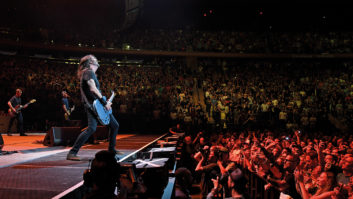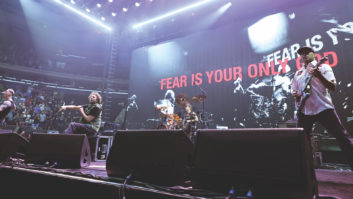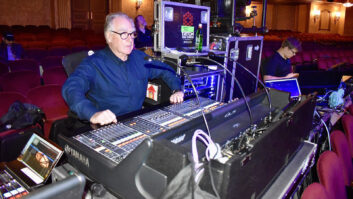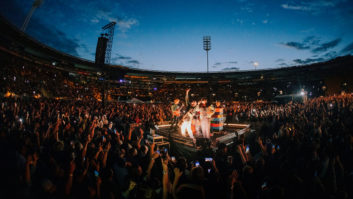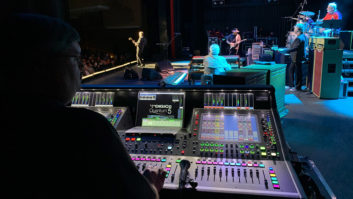
Back at the dawn of the pandemic, concert industry experts solemnly intoned that if everything fell into place—vaccines were developed fast enough and everybody masked up and the economy didn’t collapse and venues didn’t go bankrupt and we weren’t all wiped from the face of the Earth—then maybe, just maybe we’d have concerts back by 2021, but that the touring floodgates wouldn’t really open until 2022. At the time, it seemed unfathomable that it could possibly take that long—two years?! And yet here we are.
As with all prognostications, some of that came true and some aspects are still works in progress. Vaccinations and masking, after much Sturm und Drang, basically happened, if only for a while. Most large and mid-sized venues made it through, but every region had a few beloved clubs and theaters go under; in my neck of the woods, Revolution, which was home away from home for seemingly every death metal act ever, is ironically now a church. The economy didn’t collapse, but instead got schizophrenic, with the highest inflation rate in 40 years, but also roughly two job openings available for every unemployed person.
And those tours? This year’s summer tour season essentially started in February and hasn’t let up, as every artist, promoter and vendor looks to make up for lost time. The road back hasn’t been without potholes, however. Crowds are coming out, but there’s plenty of music fans who are (quite reasonably) still leery of shows, even if they’re masked and vaxxed to the max. Thanks to supply chain issues, there’s also gear and instrument shortages, and the War in Ukraine has caused worldwide gas shortages.
Live sound’s biggest setback, however, has been the massive brain drain among tour personnel. Pros of every stripe, from audio guys to management to drivers and more, have left the industry over the last two years, taking with them seasoned skill sets and institutional knowledge that will take years to rebuild with new faces—if they come into the business…and opt to stay (again—two jobs open for every unemployed person).
There’s been mass migrations out of the touring sound business before, but not on this scale. Longtime pros will recall how the industry moved seemingly overnight to digital mixing consoles 20 years ago; that paradigm shift caused many tenured touring engineers who’d learned audio “on the job” to reassess their careers and skills. After decades of working with familiar, (usually) predictable analog audio gear, the prospect of entering the digital realm, diving through layers of menus and learning a whole new way of working just to get sound that wasn’t as good as analog (early digital had some growing pains…) was a challenge that some pros simply didn’t want to take up. Weighing what it was going to take to remain relevant and employable, and then adding it to the natural desire to eventually get off the road, led many to finally leave touring and take jobs at regional audio providers that still used gear they were familiar with.
Concurrently, audio schools began upping their game after years of being regarded skeptically by the industry, and soon became a pipeline that provided a steady stream of well-trained, well-informed grads—who still had to pay their dues, mind you, but who were starting with a greater base of knowledge, if not experience.
In the ensuing two decades, those grads became seasoned pros themselves, but faced with sporadic work at best for the last two years, many have opted to move on. Now audio vendors are scrambling to staff tours and events, and while audio school grads still have to start at the bottom, that dues-paying window of sweeping the shop forever before getting to hit the road is often narrowing out of necessity. Those who don’t bring their A Game will still get filtered out—the real world has a way of doing that—but for emerging audio pros who are on the ball and determined to make it in the industry long-term, the pandemic may have handed them one of the biggest, unexpected career opportunities ever.
Opportunities in pro audio right now aren’t only reserved for live sound. Mix spent the first 10 days of June at back-to-back trade shows—NAMM and InfoComm—and on the manufacturing side, the industry is seizing every opportunity it can. NAMM, the annual convocation of musical instrument and pro audio manufacturers in Anaheim, Calif., took place for the first time since January 2020. Unmoored from its usual winter timeslot, and missing major manufacturers like Gibson, Fender and Avid, the show garnered roughly 47,000 attendees versus the usual 115,000, but most pro-audio exhibitors we spoke to were fine with that: Anyone who came out was there to do business…and business was brisk.
From there, many exhibitors scrambled to Las Vegas to set up in time for InfoComm—a show that was exploding with people (nearly 20,000). When the pandemic took live sound off the road, many manufacturers turned hard into AV integration, and the bustling booths underlined what a strong part of their businesses that has become. Between both conventions, however, the sheer number of innovative products that were released or quietly previewed underlined the fact that the industry is back and more than ready for what’s next. After two years, on all fronts, pro audio is unquestionably on the road again.

